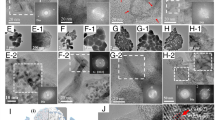Abstract
Various methods for the formation of ohmic contacts to boron-doped δ layers in CVD-diamond epitaxial structures are investigated. In the first variant, an additional thin heavily doped layer was formed on the diamond surface to which an ohmic contact is formed. Then, the surface p+ layer between the contact pads is etched out; therefore, the current in the structure flows only through a buried δ layer. In the second approach, the doped diamond selectively grows in the contact windows under a metallic mask after preliminary etching of the undoped diamond layer (cap) up to the δ layer. In this case, the heavily doped p+ layer forms an end contact to the δ layer. These two variants differ in terms of the conditions of applicability, the complexity of the manufacturing technology, the value of the contact resistance, and can be used to solve problems in which it is necessary to have a different quality of the contacts, such as the formation of transistor structures or test cells for measuring physical characteristics.




Similar content being viewed by others
REFERENCES
G. Chicot, A. Fiori, P. Volpe, T. Tran Thi, J. Gerbedoen, J. Bousquet, M. Alegre, J. Pinero, D. Araujo, F. Jomard, A. Soltani, J. de Jaeger, J. Morse, J. Hartwig, N. Tranchant, et al., J. Appl. Phys. 116, 083702 (2014).
N. Donato, D. Pagnano, E. Napoli, G. Longobardi, and F. Udrea, Diamond Relat. Mater. 78, 73 (2017).
A. Fiori, F. Jomard, T. Teraji, S. Koizumi, J. Isoya, E. Gheeraert, and E. Bustarret, Appl. Phys. Express 6, 045801 (2013).
A. L. Vikharev, A. M. Gorbachev, M. A. Lobaev, A. B. Muchnikov, D. B. Radishev, V. A. Isaev, V. V. Chernov, S. A. Bogdanov, M. N. Drozdov, and J. E. Butler, Phys. Status Solidi RRL 10, 324 (2016).
J. E. Butler, A. L. Vikharev, A. M. Gorbachev, M. A. Lobaev, A. B. Muchnikov, D. B. Radishev, V. A. Isaev, V. V. Chernov, S. A. Bogdanov, M. N. Drozdov, E. V. Demidov, E. A. Surovegina, V. I. Shashkin, A. Davidov, H. Tan, et al., Phys. Status Solidi RRL 11, 1600329 (2017).
A. Fiori, F. Jomard, T. Teraji, G. Chicot, and E. Bustarret, Thin Solid Films 557, 222 (2014).
C. Mer-Calfati, N. Tranchant, P. N. Volpe, F. Jomard, S. Weber, P. Bergonzo, and J. C. Arnault, Mater. Lett. 115, 283 (2014).
M. Ogura, H. Kato, T. Makino, H. Okushi, and S. Yamasaki, J. Cryst. Growth 317, 60 (2011).
J. F. Prins, J. Phys. D: Appl. Phys. 22, 1562 (1989).
R. Kalish, Appl. Surf. Sci. 117–118, 558 (1997).
V. Venkatesan, D. M. Malta, K. Das, and A. M. Belu, J. Appl. Phys. 74, 1179 (1993).
J. C. Pinero, M. P. Villar, D. Araujo, J. Montserrat, B. Antunez, and P. Godignon, Phys. Status Solidi A 214, 1700230 (2017).
T. Tachibana, B. E. Williams, and J. T. Glass, Phys. Rev. B 45, 11975 (1992).
J. Nakanishi, A. Otsuki, T. Oku, O. Ishiwata, and M. Murakami, J. Appl. Phys. 76, 2293 (1994).
M. Yokoba, Yasuo Koide, A. Otsuki, F. Ako, T. Oku, and M. Murakami, J. Appl. Phys. 81, 6815 (1997).
P. E. Viljoen, E. S. Lambers, and P. H. Holloway, J. Vac. Sci. Technol. B 12, 2997 (1994).
K. L. Moazed, J. R. Zeidler, and M. J. Taylor, J. Appl. Phys. 68, 2246 (1990).
Y. Chen, M. Ogura, S. Yamasaki, and H. Okushi, Semicond. Sci. Technol. 20, 860 (2005).
M. P. Dukhnovskii, A. K. Ratnikova, and Yu. Yu. Fedorov, RF Patent No. RU2436189 C1, Byull. Izobret., No. 34 (2011).
Funding
The technological part of the study was supported by the Russian Science Foundation, project no. 17-19-01580. Part of the study related to the SIMS investigations was supported by the Russian Foundation for Basic Research, project no. 18-02-00565. The electrophysical measurements were carried out as a part of the state task of the Institute for Physics of Microstructures, Russian Academy of Sciences, for 2019 (project GZ 0030-2019-0021-С-01). In the study, equipment of the Center of Collective Use “Physics and Technology of Micro- and Nanostructures” was used.
Author information
Authors and Affiliations
Corresponding author
Ethics declarations
The authors declare that they have no conflict of interest.
Additional information
Translated by V. Bukhanov
Rights and permissions
About this article
Cite this article
Arkhipova, E.A., Demidov, E.V., Drozdov, M.N. et al. Ohmic Contacts to CVD Diamond with Boron-Doped Delta Layers. Semiconductors 53, 1348–1352 (2019). https://doi.org/10.1134/S106378261910004X
Received:
Revised:
Accepted:
Published:
Issue Date:
DOI: https://doi.org/10.1134/S106378261910004X




